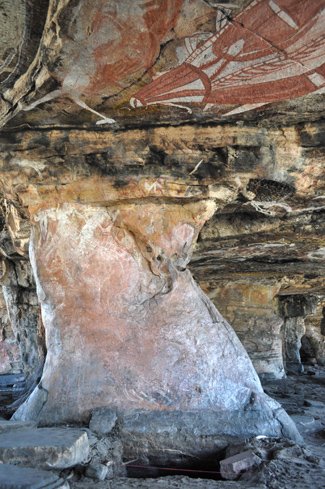35,000-year-old stone axe found in Australia

A FRAGMENT OF STONE AXE found in Arnhem Land, NT, may be the oldest ‘ground-edge’ stone tool of its kind ever discovered.
Older stone axes have been found in New Guinea, but they do not have edges sharpened by grinding. This suggests that “axe technology evolved into the later use of grinding for the sharper, more symmetrical…edges this generates,” says Dr Bruno David, lead researcher behind the find at Monash University in Melbourne.
“The ground-axe fragment is dated to 35,000 years ago, which pre-dates the oldest examples of ground-edge implements dated to 22,000-30,000 years ago from Japan and Northern Australia,” he says.
In May 2010 an archaeological dig uncovered the artefact in Jawoyn Aboriginal country of south-western Arnhem Land. A paper to be published in December in the journal Australian Archaeology now confirms the age of the find through carbon dating.
Ancient rock shelter
The axe fragment was found lying just 50 cm below the surface in ‘Nawarla Gabarnmang’, an ancient rock shelter discovered by helicopter in 2006. As the tool fragment has now been shown with carbon dating to be 35,000 years old, Bruno says “the site itself is undoubtedly older still, and there are more layers to explore underneath this”.
The process of grinding to sharpen stone tools is one of the signature developments of modern humans and it only appeared in Africa and Europe 8,500-10,000 years ago (prior to this axes were sharpened by flaking instead of grinding). Until now it was thought this technology appeared on the Pacific Rim sometime between 20,000 and 30,000 years ago. But Bruno says the new discovery “implies that for some reason people refined this kind of lithic [stone] technology here much earlier than the rest of the world.”
Professor Peter Brown, paleoanthropologist at the University of New England in Armidale says the find is exciting, but more work needs to be done to confirm the importance of the artefact. “There are numerous sites of a similar age, but if this is an example of a ground-edge tool it could be significant,” he told Australian Geographic.

The 35,000-year-old sharpened stone axe fragment
“Highly innovative“
Professor Mike Morwood, an archaeologist at the University of Wollongong, NSW, says that while we we’ve known for a while that some of the oldest sharpened tools were in Australia, this new discovery “confirms that Australian Aborigines were highly innovative – especially considering ground-edge technology is usually associated with farming cultures.”
Australia represented the end of the road for the southern arc of human migration out of Africa between 50,000 -100,000 years ago. “With nowhere else left to go, people started to have meaningful relationships with fixed places. Not only with the landscape but with each other,” Bruno says.
These tools were labour-intensive to produce and required a local knowledge of where to source the right kind of rock. Consequently they were valued objects exchanged between people. “They represented a symbolic relationship between people, the landscape and the ancestral forces of their point of origin,” he says.
A team of international experts were involved in making the discovery, including Jean-Michel Geneste, Hugues Plisson and Jean-Jacques Delannoy from France; Fiona Petchey from New Zealand and Christopher Clarkson from the University of Queensland.

